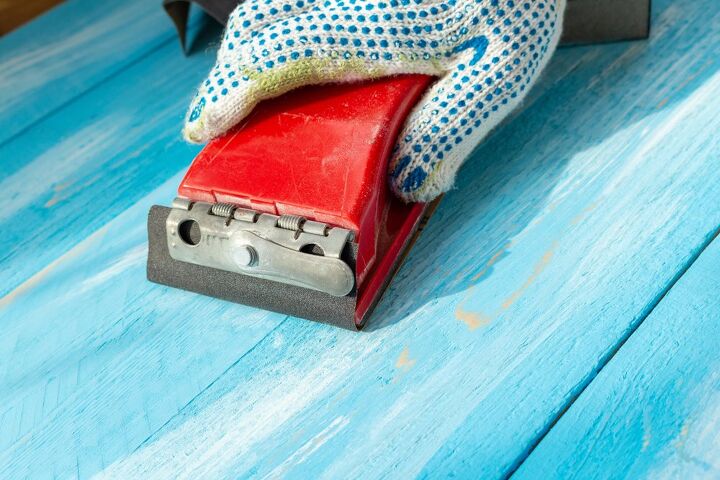What Grit Sandpaper To Remove Paint From Wood? (Find Out Now!)

You want your wood to look good. But it’s currently covered in old paint you can’t remove. So, do you strip it with liquid or buff the surface with sandpaper? Better yet, what grit sandpaper do you use to remove paint from wood? Here are your answers.
Sand paint from wood using 80-grit sandpaper first. Attach the sheet to a power sander for quicker results. Apply enough pressure to scruff the surface and loosen paint flakes without damaging the wood. Then, move to 150-grit or 220-grit for a polished shine.
Do You Need to Hire a Paint Contractor?
Get free, zero-commitment quotes from pro contractors near you.

Can You Strip Paint from Wood?
It’s easier than you think to strip paint from wooden objects. You can use powerful paint strippers or all-natural products to get rid of the old color. However, be sure to scrape the surface with a wire brush to lift paint from the grains. Otherwise, your stain or lacquer might not adhere to the wood. And if that happens, your project won’t turn out as perfect as it could be.
Should I Strip Wood or Sand It?
You have to choose between sanding the paint off wood or stripping it with chemicals. It can be challenging, especially if you don’t understand wood properties or paint etiquette. For most projects, it’s better to strip the paint than to sand it. Still, that’s not always the case.
Begin by checking the type of wood you’re using. If it’s soft or delicate, try sanding the surface first. If your wood is robust and durable, you can try a chemical bath. Either way, get ready for some hard work. Both options can cause a big mess, and neither one is faster than the other.
Do You Have to Sand All the Paint Off Wood?
Fortunately, you don’t have to strip off every speck of paint. However, you must remove all loose flakes from the surface first. Chipping, cracking, and peeling lacquer will cause your topcoat to lift and bubble. Then that old paint can stop your new layer from sticking.
It’s okay to leave some paint behind if it doesn’t compromise your finish. Test the wood by checking that the paint is flush with the surface. Old, sanded paint is easier to cover than bubbled or chipped color. But don’t forget to apply a generous coat of primer before you start. That way, your paint job lasts for years.
What Is the Best Thing to Strip Paint from Wood?
Although stripping paint from wood is easy, it’s still time-consuming. And some colors might be more of a challenge to remove than others. So, begin with steel wood to scuff the surface. It helps loosen stubborn paints and prepare the surface for sanding.
Next, try to focus on removing the stain in between the grains. You can use an old toothbrush if you can’t find steel wool. Regardless, never use metal scrapers when stripping paint from wood because it can cause deep gouges. Use chemical strippers for a stubborn stain instead.
Related Questions
What Is the Sandpaper Grit Scale?
The sandpaper grit scale is simple. It describes how coarse or fine your sandpaper is. The scale ranges from 60-grit to 320-grit, depending on the surface you’re sanding. Meanwhile, 60-grit means the paper is extra coarse, which 320-grit is ultra-fine.
Which Sandpaper Is Best for Wood?
Choose sandpaper for wood carefully. If the grit is too coarse, you could damage the surface. In most cases, the best option for stripping paint or stain off of wood is 60 to 80-grit strips. You can also use 100 to 150-grit sandpaper if you want a finer finish. And try to follow up with a power sander to catch spots you might have missed. NOTE: Always sand parallel with wood grain.
What Is Sandpaper Made Of?
Sandpaper comes in many different shapes, sizes, and forms. But most of it is attached to parchment paper using liquid adhesive. However, some sandpaper is more durable than that. Many manufacturers make their products from robust materials, including ceramic alumina, aluminum oxide, and silicon carbide.
Do You Need to Hire a Paint Contractor?
Get free, zero-commitment quotes from pro contractors near you.

Make Wood Beautiful Again
You can paint your wood if you start with a bare base. But that means stripping or sanding off the old paint, which can be a headache. So, use the best sandpaper to strip paint from wood. Or try a chemical bath if that doesn’t work. And always apply primer before painting because it can help make this process easier the next time.
Related Guides

Tiffany Nichols specializes in aesthetics, design, marketing, and manufacturing. She's a copywriter and editor for several home renovation companies in the U.S. and works alongside some of the biggest names in the industry. Her hobbies include architecture, art, mental health, and fashion.
More by Tiffany Nichols













![10 Best Electric Pressure Washers – [2022 Reviews & Guide]](https://cdn-fastly.upgradedhome.com/media/2023/07/31/9070600/10-best-electric-pressure-washers-2022-reviews-guide.jpg?size=350x220)
![10 Best Zero Turn Mowers – [2022 Reviews & Ultimate Buyer's Guide]](https://cdn-fastly.upgradedhome.com/media/2023/07/31/9070522/10-best-zero-turn-mowers-2022-reviews-ultimate-buyer-s-guide.jpg?size=350x220)

![Cost To Drill A Well [Pricing Per Foot & Cost By State]](https://cdn-fastly.upgradedhome.com/media/2023/07/31/9074980/cost-to-drill-a-well-pricing-per-foot-cost-by-state.jpg?size=350x220)
![How To Reset A Whirlpool Cabrio Washer [In 5 Easy Steps!]](https://cdn-fastly.upgradedhome.com/media/2023/07/31/9076531/how-to-reset-a-whirlpool-cabrio-washer-in-5-easy-steps.jpg?size=350x220)









